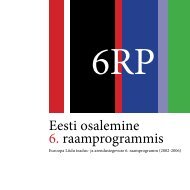Reactive Systems: Modelling, Specification and Verification - Cs.ioc.ee
Reactive Systems: Modelling, Specification and Verification - Cs.ioc.ee
Reactive Systems: Modelling, Specification and Verification - Cs.ioc.ee
You also want an ePaper? Increase the reach of your titles
YUMPU automatically turns print PDFs into web optimized ePapers that Google loves.
CHAPTER 6. HML WITH RECURSION 117<br />
expressed by the conjunct [a] i 〈a〉tt because a is the only action in our<br />
example labelled transition system).<br />
On the other h<strong>and</strong>, the process q has the option of terminating at any time by performing<br />
the a-labelled transition leading to process r, or equivalently it is possible<br />
from q to satisfy [a]ff. Let us call this property Pos([a]ff). We can express it in<br />
an extension of HML as the following infinite disjunction:<br />
Pos([a]ff) = [a]ff ∨ 〈a〉[a]ff ∨ 〈a〉〈a〉[a]ff ∨ · · · = <br />
〈a〉 i [a]ff ,<br />
where 〈a〉 i st<strong>and</strong>s for a sequence of modal operators 〈a〉 of length i. This formula<br />
can be read as follows:<br />
In order for a process to have the possibility of refusing an a-action at<br />
some point, this action should either be refused now (as expressed by<br />
the disjunct [a]ff), or, for some positive integer i, it should be possible<br />
to reach a state in which an a can be refused by performing a sequence<br />
of i actions (as expressed by the disjunct 〈a〉 i [a]ff because a is the<br />
only action in our example labelled transition system).<br />
Even if it is theoretically possible to extend HML with infinite conjunctions <strong>and</strong><br />
disjunctions, infinite formulae are not particularly easy to h<strong>and</strong>le (for instance they<br />
are infinitely long, <strong>and</strong> we would have a hard time using them as inputs for an<br />
algorithm). What do we do instead? The answer is in fact both simple <strong>and</strong> natural<br />
for a computer scientist; let us introduce recursion into our logic. Assuming for the<br />
moment that a is the only action, we can then express Inv(〈a〉tt) by means of the<br />
following recursive equation:<br />
i≥0<br />
X ≡ 〈a〉tt ∧ [a]X , (6.1)<br />
where we write F ≡ G if <strong>and</strong> only if the formulae F <strong>and</strong> G are satisfied by exactly<br />
the same processes—i.e., if [F ] = [G]. The above recursive equation captures the<br />
intuition that a process that can invariantly perform an a-labelled transition—that<br />
is, one that can perform an a-labelled transition in all of its reachable states—can<br />
certainly perform one now, <strong>and</strong>, moreover, each state that it reaches via one such<br />
transition can invariantly perform an a-labelled transition. This looks deceptively<br />
easy <strong>and</strong> natural. However, the mere fact of writing down an equation like (6.1)<br />
does not mean that this equation makes sense! Ind<strong>ee</strong>d, equations may be s<strong>ee</strong>n as
















